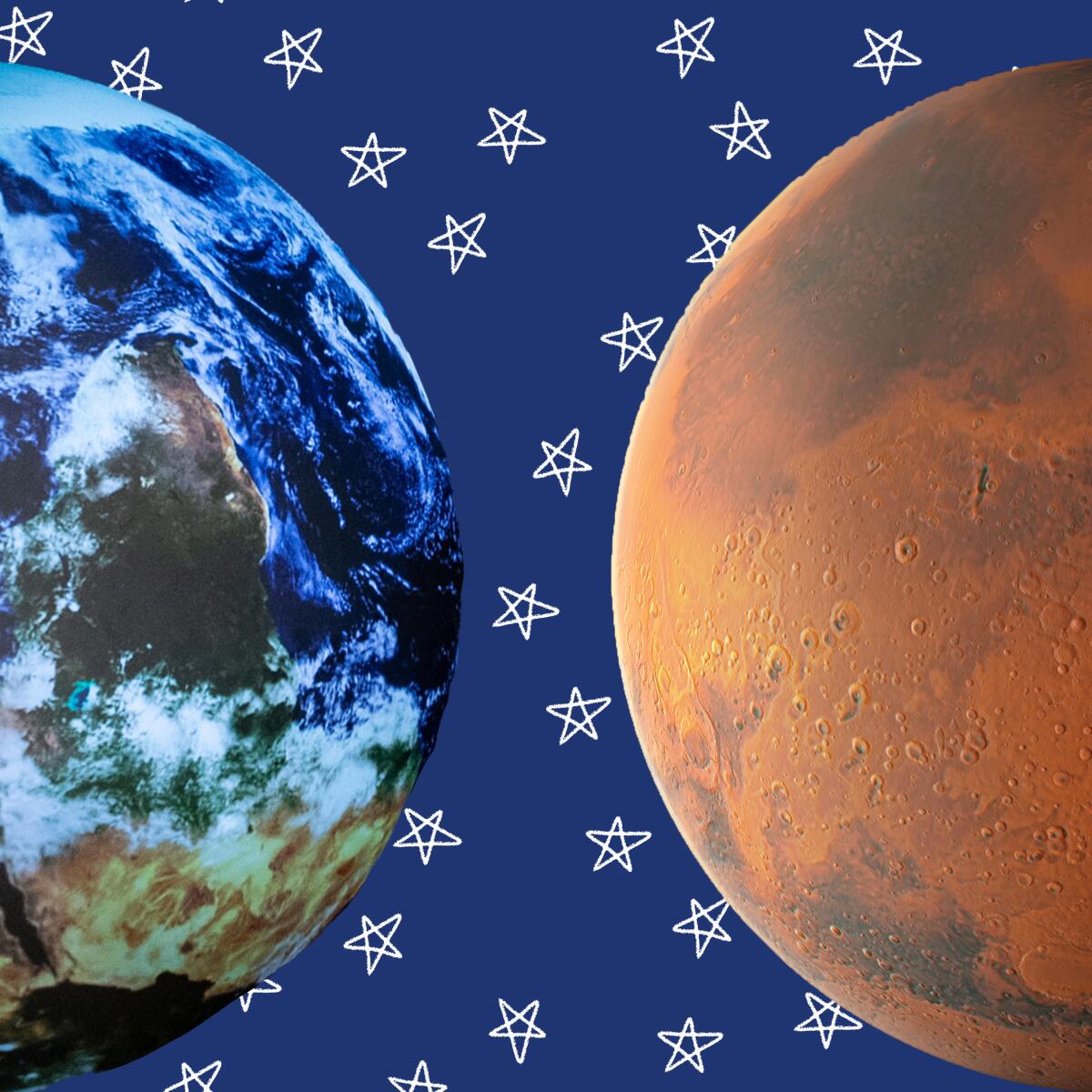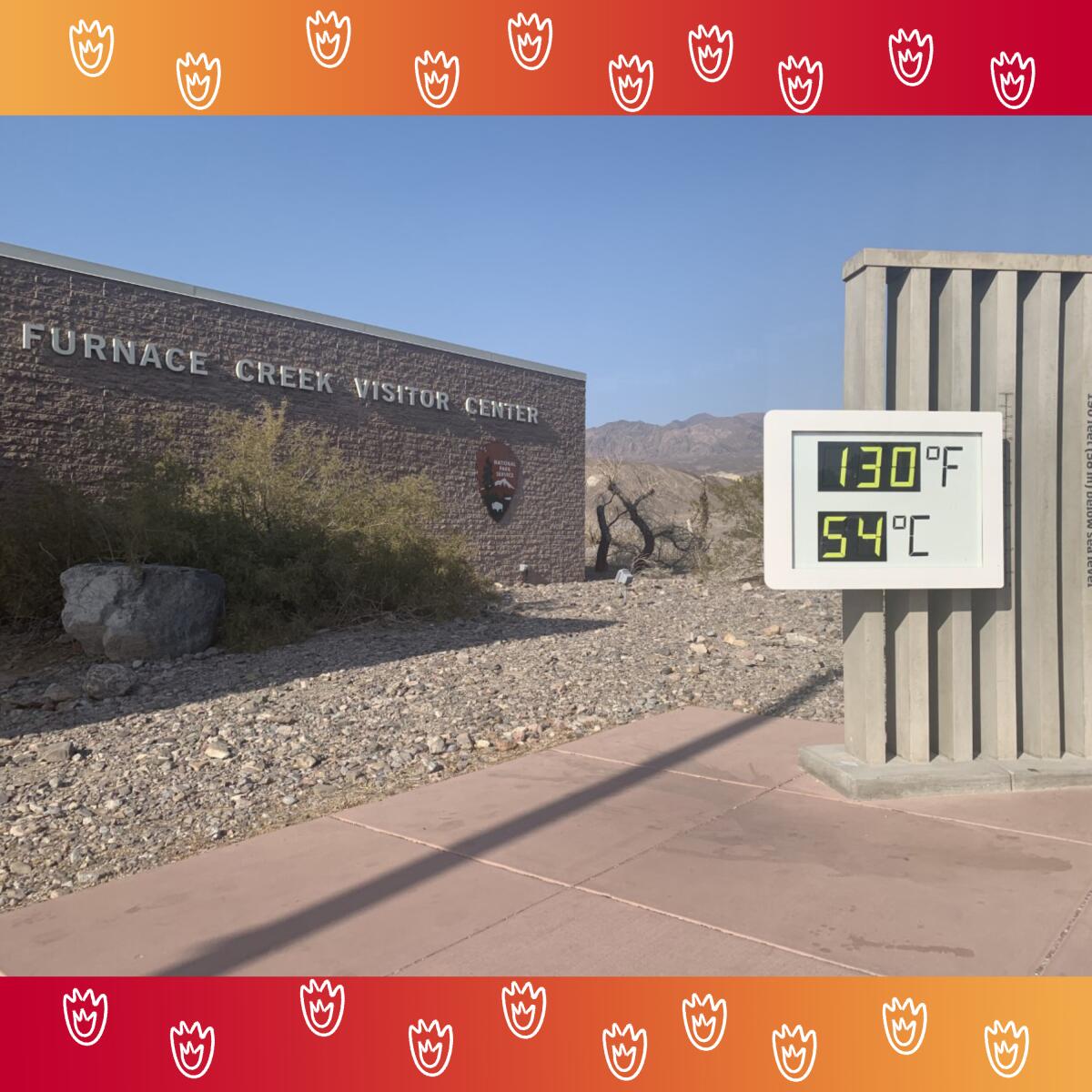The Wild: What the world will look like in 3020

- Share via
By Mary Forgione
Design and illustrations by Micah Fluellen
Sign up here to get The Wild sent weekly to your inbox.
Welcome to The Wild — and the year 3020, when a young schoolgirl takes a bus ride to a forlorn “bunker-like” mountain complex in Southern California where bald eagles, beavers, birds, rattlesnakes and other living creatures have been preserved. “I stared with avid fascination,” she thinks. “Here were the creatures I had read about and imagined for years.”
Imagine! It would be like watching saber-toothed tigers roam around L.A. But back to the future. Apparently Earth lost a big chunk of its wild side in 2070 when an outbreak of malaria prompted scientists to create disease-resistant mosquitoes. Big mistake. The engineered bugs changed the microbiomes of the bats that ate them and, well, plagues and diseases quickly spread to other mammals.
The environment perks up, but not without care and commitment from human beings, including our protagonist, who finds hope in falcons that fly freely overhead. The story isn’t mine. It belongs to Molly Hill, a young birder and high school student in Pasadena, who last year won the Green Feather Award given by Los Angeles Audubon for eco-themed sci-fi as part of the Tomorrow Prize. (You can read the entire short story here.)
Submissions for the 2020 writing competition are being accepted now through Feb. 1. “We are specifically looking for positive outcomes — stories that show overcoming our environmental challenges instead of doomsday scenarios,” the contest’s tips section says.
The pandemic may be the ideal time to encourage high school students to write about positive outcomes, to envision Earth and the environment in a different time and place, and to express in words what hope they see. I’m interested in reading what they have to say. Two virtual Q&A sessions about the Tomorrow Prize will be held Oct. 21 and 22 (sign up and find more information here).
3 things to do this week

1. Look for Mars as it sidles up to Earth. Mars and Earth will be at their closest point (only 38.6 million miles apart) on Oct. 6. It takes Mars roughly twice as long as Earth to make its way around the sun. After the approach is the Mars opposition, which sounds like a talking point for presidential debates, starting Oct. 13. “Opposition, as the name implies, simply means that the planet rises in the east, opposite to the setting Sun in the west,” according to the Complete Guide to Mars Opposition Season 2020.
Translation: It’s a good time to get a good look at Mars. You may be able to see the red planet with the naked eye if you’re in a dark place away from city lights, but you’ll get a better view with a telescope. With magnification, you’ll be able to see the planet’s dust storms and maybe even mountain ridges, according to Greg Bragg of scope-maker Celestron. He explains the best ways to watch Mars throughout October in this video.

2. Go to a drive-in or stream the film “She Is the Ocean.” The documentary “She Is the Ocean” chronicles the stories of nine women who love the sea. Sounds simple, right? Hardly. These women shoot the curls, wrangle waves and, in one case, stand in awe as a whale’s tail rises within feet of her board. Teen surfer Cinta Hansel; pro surfers Coco Ho, Keala Kennelly, Andrea Moller and Jeannie Chesser; free-diver Rose Molina and oceanographer Sylvia Earle appear in the film.
The film will screen at the Roadium drive-in in Torrance at 6:30 p.m. on Oct. 8. It costs $25 per car. Also, on Oct. 22 at 7 p.m. the Santa Barbara Maritime Museum will stream the film and host a Q&A with director Inna Blokhina as well as surfers Ho and Hansel. Cost is $12 for the film and the panel, which includes a donation to the museum. Buy tickets here.

3. Chase places in California where fall colors are beginning. Leaves are starting to turn in the Sierra and other high-elevation spots around the state. The not-so-good news: Some of the best places to see fall colors are closed, particularly the national forests and other public lands affected by fires or the hazardous air created by them.
Still, don’t give up on autumn. John Poimiroo and his band of volunteer photographers and leaf lovers at CaliforniaFallColor.com are fanning out around the state and reporting back. Images and information posted on the site are real-time. Right now keep your eye on Hope Valley and areas along Highway 88 south of Lake Tahoe, where reds and golds are popping. Check out photos and updates here.
Out there

Do you have a pair of Patagonia shorts with the (not-so-hidden) political message sewn into the label? The same words appeared in founder Yvon Chouinard’s Earth Day note to customers and on T-shirts.
Beyond the stitched words, the message has a deeper meaning about what outdoor retailers are doing right now. More and more companies have pledged to take action on climate change and have been flexing their political muscle.
Why? To show outdoor lovers — and there is no one type of outdoor lover — that they care about what we care about: protecting places we love. My colleague Sammy Roth sorts out the big impact of that tiny label on the entire outdoors industry.
By the numbers

“Heat tourism” draws visitors to Death Valley National Park each summer, sometimes with deadly results. But just how hot was this year? Below are the Fahrenheit stats (so far) for 2020, which turned out to be the fourth hottest summer season ever, according to the national park. If you plan to go soon, remember: Even October may see triple-digit temperatures.
- 130 degrees on Aug. 16, the hottest temperature in the park since 1913
- More than 120 degrees on 35 days (usually, 18.5 days)
- More than 125 degrees on eight days (usually, 2.9 days)
- More than 100 on six nights
- A 127 high and 104 low on Aug. 17 made for the hottest average daily temperature ever recorded (115.5)
The must-read

How do you write about hard questions you don’t have answers for? Two years ago, Latria Graham wrote about the challenges and obstacles of a Black woman encountering racism in the outdoors. Some people reached out to her with praise and asked her how to stay safe. She never knew what to say, until now.
Graham’s recent story for Outside is her apology/response to all the unanswered emails and messages — and it’s heartbreaking. “I am reluctant to inform you that while I can challenge white people to make the outdoors a nonhostile, equitable space where you can be your authentic selves, when the violence of white supremacy turns its eyes toward you, there’s nothing I can give you to protect yourself from its gaze and dehumanization,” she writes. People, we all need to be part of the answer. Read the full story here.
Send us your thoughts
Share anything that’s on your mind. The Wild is written for you and delivered to your inbox for free. Drop us a line at TheWild@latimes.com.
Click here to view the web version of this newsletter and share with others. I’m Mary Forgione and I write The Wild. I’ve been exploring trails and open spaces in Southern California for four decades.

Sign up for The Wild
We’ll help you find the best places to hike, bike and run, as well as the perfect silent spots for meditation and yoga.
You may occasionally receive promotional content from the Los Angeles Times.




